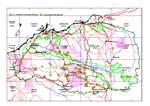Click on images
to enlarge


, Tanami Desert, A. Kalotas Dec 1984, ORIGINAL SCAN, ADJUSTED RICHARD WOODMAN_sml.jpg)
Photographer: A. Kalotas

Photographer: B.R. Maslin

Photographer: B.R. Maslin

Photographer: B.R. Maslin
, BRM 8685, lab photo by Fiona McCallum ADJUSTED_sml.jpg)
Seed from one herbarium voucher. Scale in mm. Photographer: F. McCallum.
Botanical name
Acacia tenuissima F. Muell., J. Proc. Linn. Soc., Bot. 3: 135 (1859)
Common name
Broom Wattle and Narrow-leaved Wattle
Aboriginal name
Janangungu (Kurrama) and Murruthurru (Banyjima)
Description
Multi-stemmed, resinous (but not sticky), glabrous, 'v'-shaped or rounded shrubs 1-3 (-4) m tall, with few to numerous, slender, spreading-erect stems from ground level, crowns rather dense or open and with soft, pale green to grey-green or sub-glaucous foliage which is concentrated towards ends of branches. Bark grey, smooth, the upper branches pale brown to dull reddish. Branchlets red-brown or yellowish, marked with yellow, crenulated resin-ribs. Phyllodes slender, terete to ±compressed, 6-15 (-17) cm long, 0.7-1.3 mm wide, not rigid, ascending to erect, dull green to pale grey-green or sub-glaucous; parallel longitudinal nerves numerous, fine, close together, often resinous and (at least when dry) slightly raised; apex often rigid but not sharply pungent. Inflorescences simple or rudimentary racemose, not prolific, single within axils of phyllodes; peduncles 5-10 mm long; spikes 5-15 mm long, pale yellow to light golden, densely-flowered. Flowers 5-merous; calyx ±truncate or shallowly dissected. Pods linear to sub-moniliform, to about 7 (-9) cm long, 2-3 mm wide, firmly chartaceous, straight to shallowly or moderately curved, irregularly coiled or twisted following dehiscence, light greyish brown. Seeds longitudinal in pods, 2.5-4 mm long, about 2 mm wide, shiny, dark brown to black; arils rather large, convoluted and bright yellow or orange, seeds remain dangling from pod for a short time after dehiscence.
Characteristic features
Multi-stemmed, resinous, glabrous shrubs. Branchlet apices marked with yellow, crenulated resin-ribs. Phyllodes long and slender (mostly 6-15 cm x 0.7-1.3 mm), terete to ±compressed, not rigid, finely multistriate, not pungent. Spikes pale yellow, densely flowered. Pods linear to sub-moniliform, narrow (2-3 mm wide) and thin-textured. Seeds with a relatively large, yellow or orange aril.
Distribution and ecology
Widespread in arid Australia from the Pilbara in northwest Western Australia through Northern Territory and northern South Australia to central Queensland. In the Pilbara A. tenuissima has a scattered distribution from Karratha south to near Nanutarra and east to Balfour Downs Station (northeast of Newman). Most collections are from the Hamersley Range. It commonly grows in rocky loam or clay soils, often associated with watercourses, on rocky slopes in low undulating country, but has also been recorded from sandy soil on stabilized inland dunes and spinifex plains.
Flowering and fruiting period
Flowers mainly between April and July and pods with mature seeds occur from September to November. As with its close relative A. adsurgens , this species frequently has spikes at anthesis intermingled with developing inflorescence buds and young legumes on plants at the same time.
Affinities
Acacia tenuissima is closely related to A. adsurgens with which it sometimes grows and which is readily distinguished by having flat phyllodes 2-4 mm wide. Also related to A. exilis which is most readily distinguished by its branchlets which lack the characteristic crenulated resin-ribs of A. tenuissima (see A. exilis for further details). Acacia tenuissima is superficially very similar to the bushy form of A. orthocarpa and although the two species can easily be confused they are not at all closely related. Upon close inspection (with a x10 magnification hand lens) the phyllodes of A. orthocarpa are seen to be marked with characteristic 'resin' dots and are seemingly nerveless ('resin' dots absent and fine longitudinal nerves numerous in A. tenuissima); furthermore, the pods of A. orthocarpa are broad and woody. Sterile plants of A. tenuissima resemble A. pachyacra in that they may have a somewhat similar growth from and long, thin phyllodes. However, A. pachyacra is readily distinguished by its 4-nerved phyllodes (observe with a lens at x10 magnification or greater), round flower heads which are arranged in short racemes, and its much broader pods; these two species are not at all closely related. The delicate foliage of A. tenuissima can also be similar to that of A. wanyu , a species that is readily distinguished by it densely appressed-hairy phyllodes and large woody pods.
Notes
There is very little data available on the biology or utilisation of this species, however, it is likely to be similar to A. adsurgens in these regards.
Whibley and Symon (1992) considered that A. tenuissima could make an attractive slender shrub for planting in arid areas.
Fox and Dunlop (1983) suggested that seed viability rapidly decreases in this species as evident by a fall from 89% viability for fresh seed to less than 45% viability after six months.
The seeds of Broom Wattle were eaten and used in the making of damper by some Pilbara indigenous peoples.
The seeds with their brightly coloured arils dangling from pods for a short time following dehiscence are presumably bird-attractants.
Conservation status
Not considered rare or endangered.
Origin of name
The botanical name is derived from the Latin tenuis (thin) and -issimus (very) in reference to the slender, terete phyllodes that characterize the species.
References
Fox, J.E.D. and Dunlop, J.N. (1983). Acacia species of the Hamersley Ranges, Pilbara Region of Western Australia. Mulga Research Centre. Occasional Report No. 3. pp. 94. (Western Australian Institute of Technology: Bentley.)
Whibley, D.J.E. and Symon, D.E. (1992). Acacias of South Australia. Handbook of the flora and fauna of South Australia Series. pp. 328. (South Australian Government Printer: Adelaide.)
